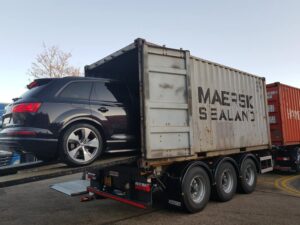The ultimate guide to importing your car into Australia from the UK including the Personal Car Import Scheme (PCIS) and Australian vehicle import laws.
We’re often asked, ‘Can I import a car into Australia from the UK?’ The short answer is you can for many vehicle models, but it’s not a simple process for the uninitiated! That’s why we’ve written this guide around how to import a car into Australia so that you can understand the process and check that your car is eligible.
In this guide, we’ll provide you with key information on shipping your car to Australia. We’ll start by outlining Australian car import laws, which are designed to ensure that all vehicles meet the country’s safety and environmental standards. We’ll also cover the necessary steps to importing a vehicle from the UK to Australia, including obtaining import approval and arranging for shipment and customs clearance.
NB: This guide is for information purposes only. Whilst we have done our best to ensure it is accurate and up to date, rules are subject to change and you should do your due diligence and speak to an adviser to assess your individual circumstances.
Free Online Car Shipping to Australia Cost Calculator
Contents
- The benefits of shipping your car to Australia from the UK
- Is it worth importing a car to Australia?
- Understanding Australian car import laws
- The personal car import scheme (PCIS)
- Personal effects eligibility criteria
- How to import a car to Australia
- Beginning the process of importing your car into Australia
- What cars are eligible for import into Australia?
- Importing classic or vintage cars into Australia
- Cost of importing a car to Australia
- Shipping your car to Australia
- Luxury car tax import calculator
- Looking for a company to ship your car to Australia?
The benefits of shipping your car to Australia from the UK
Although it may seem more straightforward and logical to just sell your UK car and buy another one when you get to Australia, you may be surprised by the benefits of taking it with you.
- Cost Savings: High-end cars in particular are a lot more expensive in Australia. Therefore, even factoring in shipping costs plus the 33% Luxury Car Tax you’ll have to pay the Australian Government, it may still be significantly cheaper to take your UK car with you than buying the same, or a similar car, in Australia.
- Australia Is Right-Hand Drive: Since Australians drive on the left side of the road, it’s easy to import your car, so why to the trouble of selling it and buying a new one?
- Availability: Many models of cars are simply not available in Australia. If you currently have one that isn’t and you want to stick with that particular model, you’ll have to take it with you. The alternative is settling for a different model Down Under.
- Sentimental Attachment: Let’s face it – many of us get emotionally attached to our cars. They have sentimental value, especially if they’ve been in the family for a while. If this sounds like you, you will definitely want to consider taking it with you when you move to Australia.
- Better The Devil You Know: Your car is like a comfortable shoe. You know its foibles and faults, all its good points, and its history with you. Most importantly, it’s reliable, and you know it’s reliable. You won’t know any of that about a new one, and Australia is a big place to break down!
- Personal Effects: Australia’s current car import laws allow people who are moving permanently to Australia to take their vehicle with them as part of their ‘personal effects’. Conditions do apply, but we’ve outlined all those for you later in this article.
Australia’s personal car import laws may look intimidating but a good car shipping company (like PSS) can take all the hassles out of shipping your car to Australia. In fact, we can even arrange it so that we pick it up at your door in the UK, and deliver it to your new door Down Under! All you have to worry about is getting yourself, and your family, there safely.
Is it worth importing a car to Australia?
Importing a car to Australia can be a viable option depending on your requirements. For example, it may be worth the investment to import a car you already own, and are familiar with, in order to avoid the hassle of getting accustomed to a new car in a new country on unfamiliar roads. 
Additionally, if the cost of the same or a similar car in Australia is more than its cost in the UK with shipping and associated costs added, then it will be worth it. Then there’s the fact that your current UK car may not be available in Australia so if you particularly like it, you’ll have to take it with you.
On the other hand, there are some drawbacks to importing a car into Australia. It can be a long, complicated process, coming on top of all the other hassles involved in moving your family to a new country! That’s where we come in handy… Additionally, depending on the age of the car and the model, it may require modifications to ensure it is eligible for use in Australia.
Understanding Australian car import laws
Australia has a unique and complex personal car import scheme. The scheme is designed to ensure that only vehicles that meet certain standards and have been inspected and approved by the Australian government, can be imported into the country. Here is a summary of the main things you need to know about Australian car import laws:
- You must be intending to ‘remain indefinitely in Australia’ and must meet certain eligibility requirements before you’ll be granted approval to bring your UK car with you. We go into these in more detail later.
- The Australian Department of Infrastructure, Transport, Regional Development, Communications and the Arts (DITRDCA) controls the importation of all motor vehicles into Australia. NB: DITRDCA was previously the Department of Infrastructure, Transport, Regional Development and Communications (DITRC).
- All road vehicles being imported into Australia require a DITRDCA-issued entry approval permit. Off-road vehicles also require entry authorisation from DITRDCA stating they are off-road vehicles and not eligible for RAV inclusion (more on RAV further down).
- It is an offence to import any type of vehicle into Australia without DITRDCA approval of some type. The fine for doing so is over AU$13,000 plus potential destruction or re-export of your vehicle.
- Under the Personal Effects Pathway (previously the Personal Car Import Scheme (PCIS), which is probably what you’ll be using, you can only import 1 road vehicle every 5 years.
- All road vehicles being imported into Australia must comply with Australian Design Rules (ADR) safety and emissions standards as set down in the Road Vehicles Standards Act 2018 (RVSA).
All vehicles (on or off-road) being imported into Australia must additionally meet strict biosecurity requirements as determined by the Australian Department of Agriculture, Water and the Environment. This includes the removal of any or all:
Asbestos in or on the vehicle (it is illegal to import any type of asbestos into Australia),
Bio-contaminants in or on the vehicle (organic matter such as soil, vegetation, animal, human etc).
This means vehicles must be thoroughly vacuumed and steam cleaned prior to departure from the UK. All vehicles are also quarantined for biosecurity inspection upon arrival in Australia and may be required to undergo further cleaning at that point (at your expense).
If you want to register and license your imported car for use on public roads in Australia, it must be entered into the Register of Approved Vehicles (RAV) maintained by the DITRDCA.
To be entered into the RAV, vehicles must be imported under either a RAV or Concessional RAV entry, or a vehicle type entry (multiple vehicles).
The personal car import scheme (PCIS)
The Personal Car Import Scheme (PCIS) allows people to import their private car if they are moving to Australia. It does not apply to commercial imports.
As per the current Road Vehicles Standards Act 2018 (RVSA), the Personal Car Import Scheme (PCIS) is now referred to as the Personal Effects Pathway. This Pathway, and the Act itself, is designed to ensure that only safe and reliable vehicles are imported into Australia. However, the scheme is complex and detailed, and it is important that those wishing to import a vehicle understand the requirements before doing so. Here’s a brief run-down on how it works.
The Personal Effects Pathway allows ‘qualified’ people to import their car from another country for personal use in Australia as part of their ‘personal effects’ i.e. household items. The scheme is administered by DITRDCA and has strict eligibility requirements that must be met in order for the import to be approved.
Personal effects eligibility criteria
Vehicle eligibility:
- The car must be more than 12 months old,
- You must have owned, AND USED, the vehicle continuously for at least 12 months immediately prior to moving to Australia.
Your eligibility:
You must be a private individual and old enough to get an Australian Driver’s License. You must also be either an expat Australian citizen returning to live in Australia permanently OR meet one of the criteria outlined in Section 6 below.
If both you and the vehicle comply with all these requirements, you may then apply to DITRDCA for an import permit and begin the process of importing your car from the UK to Australia.
Note: The PIS or Personal Effects Pathway does not apply to a company vehicle or to commercial imports.
How to import a car to Australia
This is a basic guide to importing a registered car to Australia. For more detailed information visit the DITRDCA website.
Importing your Car into Australia – what vehicle entry type approval do you need?
Individual or private car owners usually import their cars under the single-road vehicle application, which is most likely how you’ll be importing yours. There are 3 applicable sub-categories for this type of application:
1. RAV or Concessional RAV entry – this is the category you would apply for if you are bringing your personal vehicle into Australia for use on public roads under one of the following conditions:
- Personal Effects Pathway: It is your personal road vehicle, is not yet 25 years old and not a SEV, and is being imported as part of your personal effects when you migrate to Australia, OR
- 25 Years Or Older Vehicles Pathway: It is your personal road vehicle, but was manufactured more than 25 years ago, and is NOT a SEVe. it complies with the Road Vehicles Standard (RVS) Act 2018, OR
- SEV Pathway: It is your personal road vehicle (any age) but needs to be modified by a registered automotive workshop (RAW) to comply with the Road Vehicles Standard Act 2018.
All road vehicles that require RAW modification are classed as Specialist and Enthusiasts Vehicles (SEVs) and must initially be entered into the Special and Enthusiasts Register (SEVR). From there they enter the RAW system for modification upon arrival in Australia. Once the modifications have been completed, and the vehicle is certified as RVS compliant, it can be added to the RAV Register.
SEVs can be of any age; the criterion is solely that they require modification for compliance purposes. Electric vehicles are currently considered SEVs.
2. Non-RAV entry – this is a special category for vehicles that are not going to be driven on Australian public roads except under extenuating circumstances. It includes rally/racecars, test vehicles, museum or public exhibition vehicles, vehicles for use in films/advertising / promotional material, etc. Well-known examples are the ‘pope-mobile’, the British Royal Family’s Range Rover, and the US Presidential Cadillac.
3. Reimportation – this would mostly apply to Australian expats who are returning to Australia with a vehicle they originally purchased IN Australia.
Beginning the process of importing your car into Australia
Step 1: Do your research.
Importing a car into Australia is not cheap, nor is it for the fainthearted! Therefore, arming yourself with all the relevant information will ensure you make a fully informed decision.
The things you need to find out include:
- Is your vehicle eligible to be imported into Australia?
- Are you eligible to import a vehicle into Australia?
- What are the risks involved?
- What approval type do you need – we’ve outlined this in more detail below but in most cases, it will be the RAV or Concessional RAV entry approval.
- What costs will you, or could you, be up for? Note: older passenger vehicles and vehicles that will need to be modified by a Registered Automotive Workshop (RAW) are different again. Here is a complete list of applicable Road Vehicle Standards (RVS) legislation fees, charges and payments. We go into more detail regarding costs further down.
- How long do these processes take, in particular the application process? In some cases, the paperwork needs to be lodged a set amount of time prior to the activity happening.
- What documents do you need to lodge?
- What government agencies are involved, and what paperwork does each require?
- Should you use a broker?
- Does your vehicle require modification in order to comply with Australia’s RSVA Act and Australian Design Rules?
Step 2: Prepare your supporting documentation
A long list of supporting documents must be lodged with your application
Do you meet the eligibility criteria with respect to importing a vehicle?
Are you intending, or are you entitled, to remain ‘indefinitely’ in Australia? To prove that you are, you will require:
- Proof that you are an Australian citizen, OR
- Proof that you are in the process of applying to become a permanent resident, OR
- Proof that you have a visa that will entitle you to apply to become a permanent Australian resident, OR You legally own the vehicle in question when you submit the application, AND
- You legally took ownership of the vehicle whilst you were living in the UK, and proof that you are applying for, or have, a visa that permits you to stay in Australia indefinitely.
Do you meet the eligibility criteria with respect to ownership of the vehicle?
To do so, you must lodge the application within 6 months of first arriving in Australia and provide documents that verify:
You must be able to prove that you did own it AND that you either:
- Regularly drove the vehicle yourself, OR
- Drove the vehicle yourself a substantial amount of the time and the remaining use was by a person you authorised to drive it i.e. you drove it most of the time and your partner drove it the remainder of the time on public roads in the UK whilst you were living there.
‘Regular use’ means the vehicle did not spend most of its time sitting in a garage but was used regularly and frequently, and has an odometer reading and service documents to prove this use.
Documents and photos are required to be lodged (uploaded) WITH your application.
Failure to lodge any of these documents will result in your application being paused whilst authorities contact you to obtain them.
Vehicle details
- Vehicle type (van, motorcycle, passenger car etc)
- Vehicle make and model
- Vehicle year of manufacture
- VIN (Vehicle Identification Number) or chassis number
- Vehicle seating capacity
Photos of the vehicle (upload with application)
- Front view
- Side views (left and right)
- Rearview
- VIN and compliance/manufacturer’s plate
- Odometer
- Engine
Copies of supporting documents if available (upload with application)
- Your driver’s license
- Identity page from passport
- Visa documents
- Travel documents
- Receipt of purchase for the vehicle and insurance
- Registration records for the vehicle
- Servicing reports and/or receipts for the vehicle
- Rental or purchase agreement for your house in Australia
- Deed of sale of UK property or house, or UK lease / rental agreement cancellation
- Australian Tax File Number
- Letters/documents to verify intent to stay in Australia such as a letter of employment from an Australian employer, Australian utility account or receipts, Australian school enrolment record
- Resignation letter or termination of employment contract with UK or overseas employer
- Australian bank account information
- Medicare details, or application for a card
Step 3: Lodge an application for approval to import your vehicle
Once you’ve satisfied yourself that your vehicle is eligible to be imported into Australia and you have all your supporting documents ready to go, your next step is applying for approval to import it. To do this you will need to:
- Create a ROVER account or log in to your existing account (if you’re going through a broker they should already have one). ROVER (Road Vehicle Regulator) is an online portal maintained by the DITRDCA that manages all vehicle import applications and approvals under the Road Vehicle Standards Act.
- Fill out the relevant online application form.
- Pay the necessary application fee.
You should allow at least 30 days for this to be processed, and longer if you’ve missed any supporting documents.
Step 4: Wait for approval from DITRDCA.
Wait for an email from DITRDCA with your approval attached. This may contain conditions for using the vehicle once it arrives in Australia.
Step 5: Arrange to ship your vehicle
Contact a removalist or freight company that ships cars from the UK to Australia. However, before your car can actually be loaded onto a ship for its trip to Australia, there are several final things to take care of:
- Have your car steam cleaned inside and out to remove any trace of organic materials or contaminants that may pose a quarantine risk to Australia.
- Get it tested for asbestos and remove any components or parts of the car that the test indicates contain it.
- Check to make sure you don’t have to de-gas the car’s air-conditioning system.
Step 6: Arrange customs clearance for the vehicle when it arrives in Australia
Once your car has been booked to leave the UK you will need to:
- Lodge an import declaration with the Australian Border Force
- Verify the vehicle is completely free of asbestos
And pay the applicable:
- Customs Duty
- Goods and Services Tax (GST)
- Luxury Car Tax if applicable
Step 7: Arrange for a quarantine inspection upon the vehicle’s arrival in Australia
When the vehicle arrives in Australia, it will need to go through quarantine to ensure it’s free from any biosecurity contaminants. You’ll therefore need to:
- Submit a Quarantine Entry with the Department of Agriculture, Fisheries and Forestry.
- Arrange and pay for an inspection appointment that either you or your broker will likely need to attend.
Around 80% of imported vehicles FAIL their initial quarantine inspection! This is usually because areas like the wheel arches, mudguards, tyres, spare tyre, boot, and spare tyre housing have been overlooked when the vehicle was cleaned prior to import.
Step 8: Arrange for any necessary modifications to be made to the vehicle in order to meet its approval conditions.
If your vehicle is classed as a SEV it will likely be imported with conditional modification requirements to ensure it complies with the Road Vehicles Standard Act 2018. These modifications must be carried out by a Registered Automotive Workshop (RAW) once the vehicle arrives in Australia and has cleared Customs and Quarantine. One typical modification is ensuring the vehicle has compliant seatbelts.
You will then need to provide (gather) evidence that the vehicle is now compliant. This is usually done via testing. Once this has been done, you can apply to have the vehicle entered into the Register of Approved Vehicles (RAV).
Step 9: Get it registered and insured in your respective state or territory
You now have to arrange for your vehicle to be licensed in your state or territory of residence. This may involve obtaining a permit or pass to drive the unlicensed vehicle to your nearest inspection centre or taking it there on a car trailer or transporter.
It’s also entirely possible there will be further compliance modifications required at the state level around window tinting levels, legal light bulbs, tow hitch and front bumper requirements if fitted and so on. Each jurisdiction has its own regulations in this regard so you’ll need to contact your state traffic authority to ascertain what you need to do.
As the vehicle owner, you are responsible for all the various fees, charges and taxes that will be incurred.
What cars are eligible for import into Australia?
Many of the previous restrictions around the makes and models of vehicles that could be imported into Australia under the PCIS (now PEP) have been lifted. Therefore, for the purposes of migrating to Australia, so long as your car qualifies for import into Australia under one of the various import pathways, you shouldn’t have too much trouble bringing it with you.
Private cars for use on public roads include most standard passenger vehicles designed to carry less than 2 tonnes and up to 8 passengers. You can import most makes and models so long as they comply, or can be made to comply, with Australia’s Road Vehicles Standards Act.
Example list of approved vehicles for import
Some of the more popular cars that have been successfully imported to Australia from the UK in recent years include:
- Aston Martin DB9
- Audi A3 / A4 / A7 / Q5 / TT
- Bentley Continental GT / Mulsanne
- BMW 3 Series / 5 Series / X5
- Ford Focus / Kuga / Mondeo
- Jaguar F-Type / Jaguar XF / Jaguar XK
- Land Rover Discovery / Freelander
- Lotus Elise
- Mercedes-Benz C-Class / E-Class / G-Class SUV
- Mini Cooper / Countryman
- Nissan Qashqai
- Porsche Cayenne
- Range Rover Evoque / Sport
- Rolls-Royce Ghost
- Vauxhall Astra / Insignia (previously sold as Holdens in Australia)
- Volkswagen Golf
- Volvo XC90
If you own any of these, it’s safe to say you’ll have to bring it with you if you want to continue driving one in Australia! Many of the high-end ones would also probably be classed as luxury cars.
European cars are subject to the same conditions as any other private car or SEV.
Luxury cars in Australia are defined as those worth more than a certain value in AUD called the Luxury Car Threshold. This is irrespective of make or model. The Australian Tax Office (ATO) sets this threshold annually. Currently (2022-2023) this is AU$71,849 for ‘Other Vehicles’ and AU$84,916 for ‘Fuel Efficient Vehicles’, inclusive of GST.
If you import any car into Australia that is valued above this threshold, it is subject to a 33% Luxury Car Tax (LCT) on top of GST.
Older cars are cars that are more than 25 years old. This age is now calculated via a rolling manufacturing year. Currently (2023) that year is 1997. In 2024 it will be 1998 and so on. Older cars may or may not have to be modified for public road use in Australia. If they do, they are considered SEVs.
Specialist and enthusiasts vehicles (SEVs) must be listed on the Specialist and Enthusiast Vehicles Register (SEVR) before you can apply to import them. These are cars that require modification for public road use in Australia or are electric vehicles. They must also be added to the RAW system.
Off-Road vehicles are vehicles that were not manufactured for road use and can’t ever be registered for road use, regardless of modifications. So long as you can convince the DITRCDA that your vehicle is not, and never was, intended for on-road use, it does not require an import permit. They will then issue you a notice advising that it is not a road vehicle. As your off-road vehicle is still required to go through the Australian Quarantine and Customs system, you need this notice so Australian Border Force can release your vehicle. Off-road vehicles must also comply with the Australian Design Rules safety and emissions standards.
List of approved vehicles for import to Australia – off-road:
- Agricultural machinery including tractors, harvesters, balers etc
- Tracked earth-moving machinery such as bulldozers, excavators etc
- Golf carts
- Motorised recreational devices such as motor-assisted rollerblades, skateboards and unicycles
- Light utility vehicles (small vehicles designed for transporting people and/or goods around a property like a holiday resort, farm, or factory)
- Miniature motorbikes (mini-bikes or pocket bikes)
- Motorised mobility devices (wheeled chairs designed for people who can’t walk or have difficulty walking)
- Personal mobility devices such as electric scooters or Segways
- Power-assisted pedal cycles
- Quad bikes
- Drag racing cars
- Go carts
Importing classic or vintage cars into Australia
Classic or vintage cars can be imported into Australia but may have to be modified when they reach Australia and are therefore considered SEVs (Specialist and Enthusiasts Vehicles).
This means they need to be entered into the Registered Automobile Workshop (RAW) system before they can be added to the RAV.
Cars that are more than 30 years old are exempt from customs duty.
Cost of importing a car to Australia
The total cost of importing a car to Australia from the UK depends on the type of vehicle, its age, and the state or territory you are importing the vehicle into. There are the costs related to the importing of the vehicle and then there are state registration fees and local on-road costs.
Typically, the cost of importing to Australia includes:
- RAV Personal Effects application fee (AU$50)
- Non-RAV entry import approval AU$60
- Reimportation import approval AU$40
- RAV levy charge (depends on vehicle type and is paid with the application fee). A passenger vehicle levy for a car being imported as a Personal Effects vehicle for example is currently AU$7.20 so the total fee is AU$57.20.
- Cleaning fees prior to departure from the UK,
- Shipping fees to Australia + insurance,
- Quarantine fees in Australia (may include more cleaning fees),
- Customs duties 5%,
- Goods and Services Tax (GST) 10%,
- Luxury Car Tax (LCT) if applicable 33%,
- Storage and delivery fees,
- Logistics services fees,
- Import processing fees,
- Wharf and transport fees,
- Federal modification costs if applicable,
- State and Territory vehicle compliance/on-road costs if applicable,
- State and Territory vehicle licensing fees,
- Insurance,
- Brokers fees if you’ve hired one to help with any stage of the import process.
Shipping your car to Australia
Shipping your car to Australia is definitely going to be a lot easier if you get someone like PSS Removals to take care of it for you. We not only know the in’s and out’s of Australia’s very complex personal car import legislation, but we also have a network of reliable contractors here in the UK and in Australia who will take the very best care of your car for you.
After all, if you’re going to the expense of taking it Down Under with you, you definitely don’t want anything happening to it along the way!
For security and ease we usually recommend using a container shipping service than a RORO (Roll on, Roll Off) service for shipping your car.
This has the added advantage that you can ship your car together with your household goods and personal effects which can be very cost-effective.
To find out more, check out the guide on shipping your car to Australia from the UK.
Luxury car tax import calculator
Because of the complexity of Australia’s car import fees, you will almost certainly need a Car Tax Import Calculator to help you work them out. The formula used is the Purchase price of the vehicle + Customs Duty 5% + Shipping cost = GST taxable value of the vehicle. You then pay both the 5% Customs Duty as well as the %10 GST. All calculations are in AUD.
| Purchase price of the car: | $50,000 |
| Customs duty: | $2,500 |
| Shipping costs: (Note: this figure is for illustrative purposes only) | $5,000 |
| GST taxable value of the vehicle | $57,500 |
| Taxes payable: | |
| Customs duty: | $2,500 |
| GST | $5,750 |
| Total Tax Payable | $8,250 |
If your car is over 30 years old, you don’t have to pay Customs Duty (regardless of purchase price) so in this example you’d just be paying the $5,500 GST calculated by adding the purchase price of the vehicle + the shipping cost.
If your car exceeds the Luxury Car Threshold (and is ‘younger’ than 30 years old) you will need to factor that into your calculations as well.
Looking for a company to ship your car to Australia?
Shipping your car to Australia has several advantages. Firstly, it eliminates the need to rent a car or purchase a new one upon arrival, which can save you time and money. Additionally, it can be more cost-effective than buying a new car in Australia, particularly if your current vehicle is in good condition and has sentimental or practical value to you.
However, it’s important to do your research before making any final decisions. You’ll need to factor in the cost of shipping, insurance, taxes, and other fees. You’ll also need to ensure that your car meets Australian safety and emissions standards and obtain the necessary permits and paperwork before shipping.
If you do decide to ship your car to Australia, it’s essential to do your research and choose a reliable and experienced shipping company. PSS is one such company that offers a cost-effective solution for shipping your car to Australia, along with your other personal effects. Their expert guidance and assistance can help you navigate the shipping process smoothly and with minimal stress. Get a quote today to start the process.









